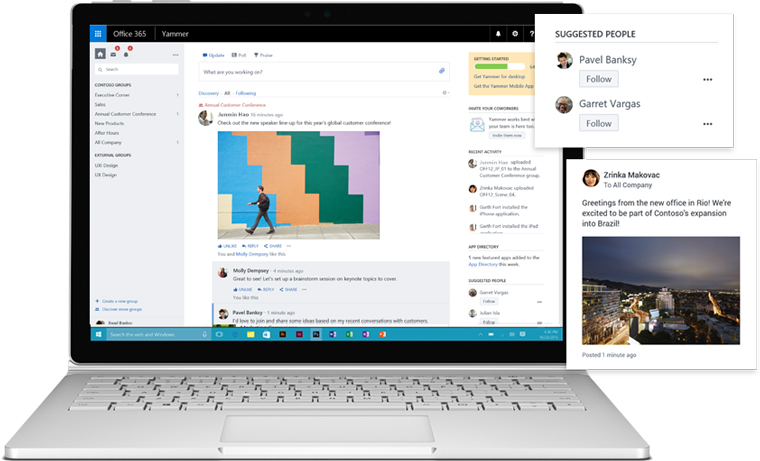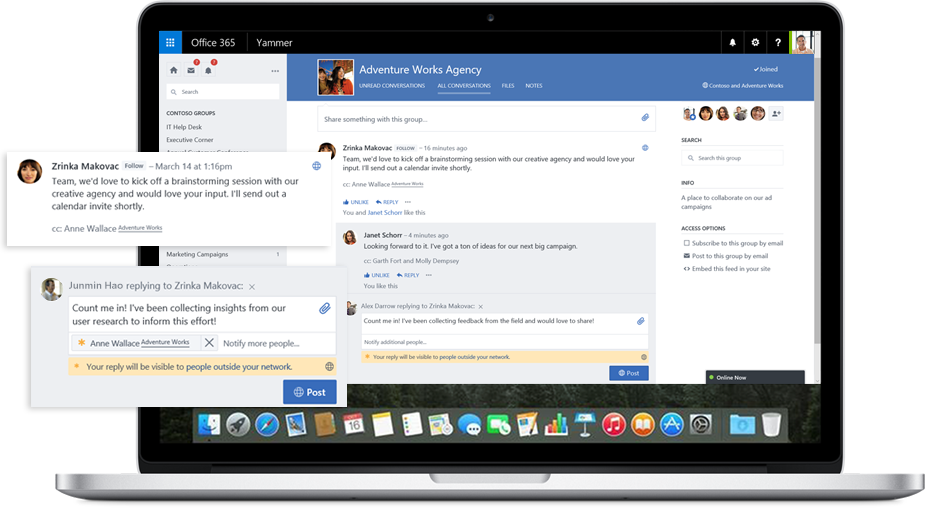Three Reasons Your Business Should be Using Yammer
Three Reasons Your Business Should be Using Yammer
In today’s competitive marketplace, people must work smarter and faster than ever before. Business executives and IT leaders know they need to continuously look for new ways to improve communication and collaboration within the workplace to maintain a competitive advantage. In response to this growing business demand, Microsoft created Yammer in Office 365.
What Is Yammer?
Yammer is essentially a social network that's entirely focused on your business. While the idea is to enable collaboration within the workplace, you can also create external networks to allow non-employees, such as customers, partners, and vendors, to communicate with your company.
I have seen many of my clients discount Yammer as Microsoft’s attempt at social media which they feel doesn’t have a place in their company. But by doing this, they discount what Yammer really is – an organic knowledge repository of information and idea sharing. It’s not uncommon for people to send emails (this is how we’ve traditionally conducted business) but it is also not uncommon for things to get lost in email.
By using a tool where people can openly and securely share information, we are cutting out the middle-man, cutting down on email, and getting to the source faster and with greater ease. This is why, time and again, I recommend Yammer to our users as a way to share ideas with larger groups.
There are three big reasons to give Yammer a try
1) Organic Knowledge Repository
Teams and organizations can use Yammer groups to ask questions and share ideas with each other. Generally, we see these groups being created for larger sets of people, rather than an individual team – think department – where people can come to gather information or ask questions and the group can crowd-source the answer.
A very specific and real example is creating an HR Benefits group. This isn’t a place to ask very specific and personal questions, but rather, a place people can start conversations about what benefits are available, or it can be a cross-functional group interested in what “the cloud” is offering. The members can come to this place to share what they have found or inquire with their colleagues on best practices.
In either of these cases, this information is stored in this organic knowledge repository for others to find, ask questions, or comment. It is not stuck in someone’s email inbox, or even worse, Deleted folder.

2) External Collaboration
Yammer allows you to have internal conversations with the groups you are a part of, but it also allows you to open up the dialogue with external members, too.
As Office 365 has developed and new products are being added, one requested feature is the ability to add external members to different products. Office 365 Groups and Teams saw this functionality added in 2017, but this has been a feature of Yammer for much longer.
By adding your clients, vendors, or contractors to Yammer, you are able to extend the organic knowledge management even further. An email sent to an external member is more than certainly going to be lost in terms of knowledge capital.

3) Work Seamlessly, Wherever You Are
By 2022, the global mobile workforce is set to increase to 1.87 billion people or 42.5% of the global workforce. This is up from 38.8% in 2016. As workers become increasingly mobile, so does their primary work device. Evolving with this trend, employees are also moving toward smaller, more portable devices and tablets, wearables, and ultrabooks, which are expected to be the primary work devices by 2020.
Yammer does not limit you to your desktop, or even your computer. You can take all of the communication and collaboration benefits with. With Yammer's mobile application, you can stay on top of conversations and share your insights, wherever you are.
Is Yammer Here to Stay?
A final trend to consider: By 2020, the workforce will be compromised of five different generations for the first time in history. And by 2025, more than 70% of the workforce will be millennials. Millennials’ affinity with the digital world is the defining characteristic – they have grown up with smartphones, laptops, and social media being the norm. They expect instant access to information whenever and wherever they wish. This is reflected in both their personal life and work life. This growing group of workers values similar things in an employer and this will continue to drive workforce transformation and tool-adoption within businesses.
Yammer is not going away and once-skeptical businesses are realizing the value in its ability to transform workforces by improving communication and collaboration!

SHARE